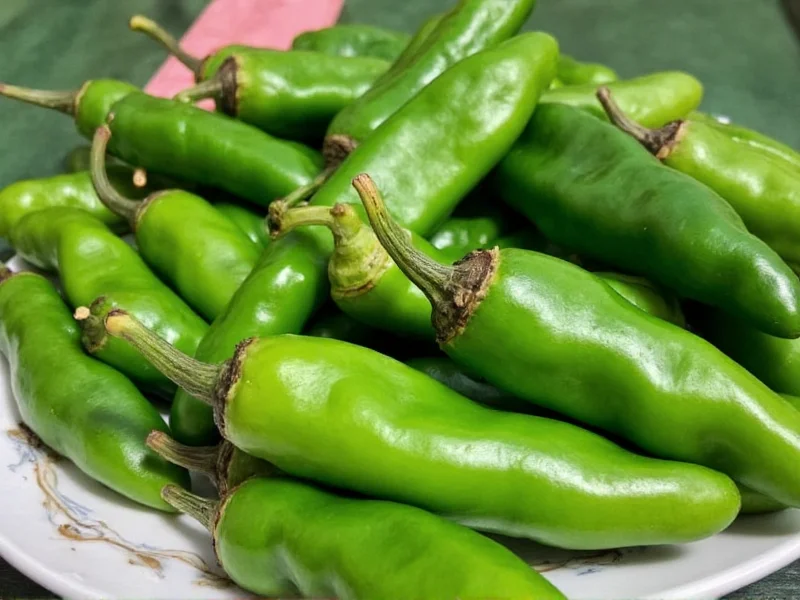Dried serrano peppers transform the bright, grassy heat of fresh serranos into a more complex flavor profile with subtle smoky notes. While fresh serranos typically measure 10,000-23,000 Scoville Heat Units (SHU), the drying process concentrates capsaicin, pushing dried versions to 22,000-35,000 SHU. This makes them hotter than jalapeños but milder than habaneros, positioning them perfectly for dishes requiring noticeable heat without overwhelming spice.
Understanding Dried Serrano Characteristics
The dehydration process fundamentally changes serrano peppers' chemical composition. As moisture evaporates, natural sugars caramelize while volatile compounds concentrate, creating richer flavor dimensions. Unlike chipotles (which are smoked jalapeños), dried serranos develop their characteristic flavor purely through dehydration, not smoking—though some producers offer smoked variants.
| Characteristic | Fresh Serrano | Dried Serrano |
|---|---|---|
| Heat Level (SHU) | 10,000-23,000 | 22,000-35,000 |
| Flavor Profile | Grassy, bright, vegetal | Smoky, earthy, complex |
| Texture | Crisp, fleshy | Leathery, brittle |
| Shelf Life | 2-3 weeks refrigerated | 1-2 years properly stored |
Practical Uses for Dried Serrano Peppers
Understanding how to use dried serrano peppers unlocks their culinary potential. For rehydrating dried serrano peppers, submerge them in hot water for 15-20 minutes until pliable. This reconstituted form works well in salsas, moles, and sauces where fresh pepper texture is desired.
Chefs frequently employ whole dried serranos in slow-cooked dishes like recipes with dried serrano peppers for pozole or bean stews, removing them before serving like a bay leaf. For consistent heat distribution, many prefer making dried serrano pepper powder by toasting peppers briefly then grinding them in a spice grinder.
Storage Methods for Maximum Freshness
Proper storage methods for dried serrano peppers significantly impact longevity and flavor retention. Store them in airtight containers away from light and moisture. Glass jars with tight seals work better than plastic bags, which can allow moisture transfer. For extended storage beyond six months, keep them in the freezer where they maintain potency for up to two years.
Check for quality by examining color—vibrant red or green indicates freshness, while faded or brownish hues suggest degradation. Properly stored dried serranos should snap cleanly when bent; flexibility indicates moisture absorption and potential mold risk.
Finding and Substituting Dried Serranos
When determining where to buy dried serrano peppers, check Latin American markets, specialty spice shops, or well-stocked grocery stores. Online retailers offer the widest selection, including organic and heirloom varieties. Some stores carry them near other dried chilies, while others place them in the international foods section.
If unavailable, suitable substitute for dried serrano peppers includes guajillo peppers for milder heat with similar earthiness, or a combination of cayenne and pasilla peppers to approximate both heat level and flavor complexity. Fresh serranos can substitute in a 3:1 ratio (three parts fresh to one part dried), though the flavor profile will differ.
Nutritional Benefits and Safety
Dried serrano peppers retain most nutrients found in fresh versions, concentrating certain compounds through dehydration. They're rich in vitamin C (even when dried), capsaicin (with potential metabolic benefits), and various antioxidants. One dried serrano contains approximately 5-7 calories, no fat, and minimal carbohydrates.
When handling dried serranos, wear gloves to prevent capsaicin transfer to sensitive areas. The concentrated oils can cause significant irritation, especially when grinding peppers into powder. Always work in well-ventilated areas to avoid inhaling fine particles.
Popular Culinary Applications
Chefs value dried serranos for their versatility across cuisines. In Mexican cooking, they feature prominently in adobo sauces and chorizo seasoning. For how to use dried serrano peppers in cooking beyond traditional applications, try adding whole peppers to olive oil for infused cooking oil, or include them in dry rubs for meats where their heat penetrates deeply during slow cooking.
Home cooks often overlook the stems, but these contain significant capsaicin. When making dried serrano pepper powder recipe variations, include stems for extra heat, or remove them for a more balanced flavor profile. Toasting peppers briefly in a dry skillet before grinding enhances their aromatic compounds.
FAQs About Dried Serrano Peppers
How do dried serrano peppers compare to chipotles in heat level?
Dried serranos (22,000-35,000 SHU) are significantly hotter than chipotles (2,500-8,000 SHU), which are smoked jalapeños. Serranos deliver sharper, cleaner heat while chipotles offer smoky sweetness with milder spice.
Can I substitute dried serrano peppers for fresh in recipes?
Yes, but adjust quantities carefully. Use one dried serrano for every three fresh peppers, as drying concentrates capsaicin. Rehydrate dried peppers first for texture similar to fresh, or grind them for even heat distribution in sauces and rubs.
Why do my dried serrano peppers taste bitter?
Bitterness typically results from over-toasting during drying or improper storage. Avoid direct sunlight and moisture exposure. If bitter, try soaking peppers in warm milk or citrus juice for 10 minutes before use to neutralize bitter compounds.
How can I tell if dried serrano peppers have gone bad?
Signs of spoilage include mold growth, musty odor, significant color fading, or flexibility when bent (should snap cleanly). Properly stored dried serranos maintain vibrant color and brittle texture for 1-2 years. Discard if any off smells or visual changes appear.











 浙公网安备
33010002000092号
浙公网安备
33010002000092号 浙B2-20120091-4
浙B2-20120091-4